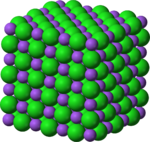Kinds of Matter
Claimed by Kristen Sparks
This topic covers the Different Kinds of Matter.
The Main Idea
No matter how how big or small the matter, physics can be applied to all objects.
Atoms and Nuclei
All matter is made of atoms. To understand the properties of matter around us we look at atomic properties and interactions. Atomic interactions can be attributed to the attractive and repulsive forces due to the different parts of an atom which are: protons, electrons, and neutrons. Protons and neutrons make up a small, dense center called a nucleus. Around the nucleus are electrons, whose negative forces are attracted to the positive center.
The number of neutrons and protons in specific chemical elements can be found on the periodic table.
Molecules and Solids
When atoms bond together molecules are formed. Molecules can be made up of any number of chemical elements, but as a whole the molecule's properties differ from the properties of its subelements.
Solids are rigid objects made up of molecules. Scanning tunneling microscopes (STMs) are used to see molecules and atoms that make up everyday solids. STMs can observe patterns and irregularities that may occur on the surface of solids, which have helped scientists understand more about what happens on the atomic level of matter.
Liquids and Gases
Liquids are formed when solids are heated. Atoms begin to vibrate too fast to maintain their normal rigid positions. If the temperature increases enough atoms will start to shift past one another therefore becoming a liquid. If the temperature is further increased the sliding of atoms will turn into interatomic bond breaking which will lead to gas formation.
Planets, Stars, Solar Systems and Galaxies
Plants and stars make up solar systems, and multiple solar systems make up galaxies.
Point Particles
Point particles are often used to analyze more complicated/large objects. Physicists assume that these objects have been compressed into structures where size, shape and internal structure are not taken into consideration: a tiny speck with equivalent mass as the object its representing.
Examples
Atom
Crystalline Solid
STM Image
See also
External links
http://www.livescience.com/46506-states-of-matter.html
Internet resources on this topic
References
This section contains the the references you used while writing this page


